How (and when) to water cannabis
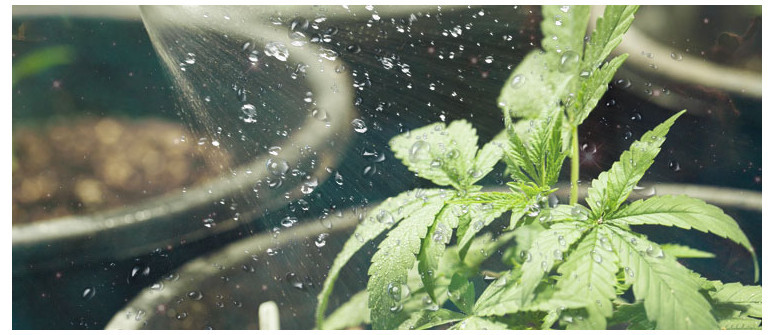
Plants, like all living things, love water. However, this doesn't mean that more is always better. Learning to recognise when your plants need more water, and when they need less, is a simple but essential step in becoming a master grower. This guide will give you the information necessary to understand cannabis and its liquid requirements.
Contents:
- Which Water Sources Can You Use To Grow Cannabis?
- When To Water Cannabis Plants
- Beginner Tips for Watering Cannabis Plants Properly
- How To Water Your Cannabis Plants
- How To Water Marijuana Clones
- Overwatering and Underwatering Cannabis Plants
- Watering Cannabis When You’re Away
- Properly Watering Cannabis: Important, But Easy
Watering cannabis plants seems easy, right? Right! But getting the frequency correct is essential to your crop’s health. Overwatering is far more common, and far more damaging to your plants, compared to underwatering (in most cases).
How often your cannabis plants need water depends on numerous factors, from phase of growth, to pot size, to heat emitted by your lights, to the type of growing system you choose—so following someone else’s schedule won’t do.
Likewise, the water source itself will vary from grower to grower.
Nearly all aspects of a grow—watering included—are exclusive to that operation. Environment, strain, and water source will all impact the growth and development of your crop in some way.
So below, we offer guidance on how and when to water your weed plants so you can perfect the art of watering.
Which Water Sources Can You Use To Grow Cannabis?
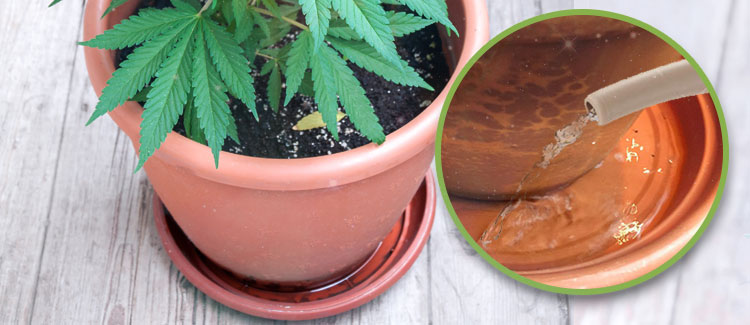
Choosing the right water source for your cannabis plants is the first step in ensuring a successful watering regimen. You can learn all you’d like about the nuances of each strain and concoct a nutrient mix to suit, but this could all be thrown off by a mineral-rich water source.
That being said, unless you’re after an absolutely perfect grow, it’s important not to get too hung up on water source. So long as the source you are using is satisfactory, you shouldn’t see poor results.
An ideal water source features:
- A pH of 6.0–6.8 (5.5–6.0 for a hydroponic grow)
- A low mineral ppm, meaning few contaminants
- No biological contaminants
- A temperature of around 21°C
Other considerations when choosing a water source are:
- Cost (both initial and over time)
- Availability
- Environmental impact
- Ease of collection
For many growers, taking all of these factors into equal consideration may not be a privilege to which they are privy. Cost and accessibility are likely to be the determining factors when considering which water source to opt for.
So, depending on which you have access to, what are the pros and cons of each?
Tap Water
Using unfiltered tap water will, for most growers, be the cheapest and easiest option. And in many cases, it will more or less suffice.
If you live outside a city, it’s likely your tap water will be more suited to immediate use for growing cannabis. If you’re in a dense urban environment, however, the chemical contamination of your tap water is likely to be higher. The simplest way to somewhat remedy this is to leave it to sit for 24–48 hours before using it. In doing so, chemicals such as chlorine (which can damage the ecosystem in the soil) will evaporate.
It is also likely that the pH of your tap water will be a little higher than suitable. A simple pH up/down balancing solution should sort this, along with a pH meter.
Though you can invest in expensive reverse osmosis water filtration systems, a simple household water filter (like those used to purify drinking water) will hugely increase the purity and suitability of your tap water too. This is the most inexpensive way to purify tap water.
Collected Water
Be it rainwater, or water collected from a natural source, collected water can be a cheap and sustainable way to source water for your cannabis plants.
From a Water Source
Water collected from a natural water source, such as a river, can vary wildly in pH and contaminants. Therefore, it’s important to test it thoroughly before giving it to your plants.
It could well be that it’s wonderfully balanced and has the perfect, slightly acidic pH. But it could also be that it’s full of farm runoff and biological contaminants. Check it before you use it!
Collected Rainwater
Collecting rainwater is, besides the initial investment in a water butt, free. Likewise, it is relatively free of contaminants. If you are able to collect rainwater, it tends to be a very viable option with little to no environmental impact. Just ensure that it is stored in such a way that it doesn’t harbour biological growth.
Bottled Water
Bottled water is well-balanced, fairly pure, and relatively cheap. It is an easy option if you want to water your cannabis with pure water. However, the environmental damage wrought by plastic waste needs little explanation, so we don’t advise using this method. Not only this, but collecting, transporting, and packaging this water adds a whole load of unnecessary damage. There are, generally, far better options.
When To Water Cannabis Plants
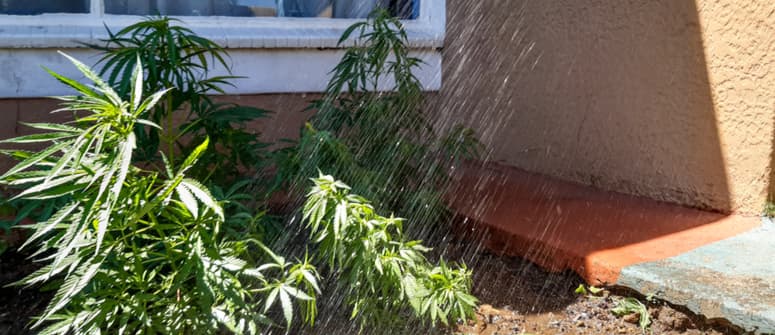
Knowing when to water your cannabis can be tricky, and there’s a lot of conflicting information out there. Some recommend watering every few days, while others claim a litre and a half of water is needed each and every day during the flowering phase. However, it’s much better to observe the plants themselves, as opposed to following a strict regimen.
Here's some advice on when to water marijuana plants growing in containers, garden beds, and hydro systems.
In Containers With Soil
Luckily, watering plants in a soil grow needn’t be hard.
In fact, testing the soil is probably the best way to tell if your plants need water. Waiting for them to wilt is going to give you stunted specimens with poor yields, whereas belligerently watering every X days is going to drown them.
Allowing the soil to dry between watering is great for root health, as it gives them ample time to breathe. Leaving them soaked causes root rot and can kill them.
The easiest way to test the soil is simply to feel it. Press a finger about a knuckle deep, or 5cm, into the substrate. If it feels dry, it’s probably a good idea to water it. Otherwise, you can lift the pots and see whether they feel saturated. To get an idea for this, you’ll need to know how much they weigh when dry. If they’re very heavy, they’re probably quite wet. If they feel airy and light, give them some water.
In Garden Beds
The above guidelines are simple to follow in a controlled indoor grow. However, growing outdoors in a soil bed can be a little more difficult. Roots can go deeper, and the topsoil is likely to be less indicative of the overall water content. Likewise, you may water one day, only to find it pouring down with rain two hours later.
So, if growing outdoors in a bed, you’ll have to keep a slightly closer eye on the plants themselves. The positive side of growing in this way is that you’re likely to have much better drainage, and thus should be able to adopt a more regimented watering schedule.
So long as you’re not drowning them, the soil will be far more capable of evening out the water content. Your cannabis plants are unlikely to be the only things using the water; the vast roots of nearby trees will likely be grateful too.
In a Hydroponic Grow
It’s in the nature (and indeed the name) of a hydroponic grow for the roots to be exposed to water. More specifically, some hydroponic methods subject the roots to water intermittently, while others leave the roots fully submerged in an aqueous solution 24/7. So speaking of watering in terms of a hydro grow can seem a little redundant.
However, it’s still essential to keep an eye on your plants, watching for all the same signs mentioned above. Fortunately, in a hydroponic grow, you also have the luxury of viewing the roots themselves, giving you great insight into their health.
Can You Water Cannabis Plants at Night?
Though the answer to this question is by no means agreed upon, we would not recommend watering your plants at night. There are a few reasons for this:
- Plants expend most of their energy during the day, so water and nutrients are required most during this time.
- Being very wet in cooler periods increases the likelihood of infestation.
- Plants lose water in the heat of the day (or beneath lights), and will absorb it more readily during this time.
Watering during the morning, for both indoor and outdoor grows, appears to be the most suitable. This gives plants ample food and water for the day, and means that once the cool, dark night comes around, the soil is not too wet.
Beginner Tips for Watering Cannabis Plants Properly
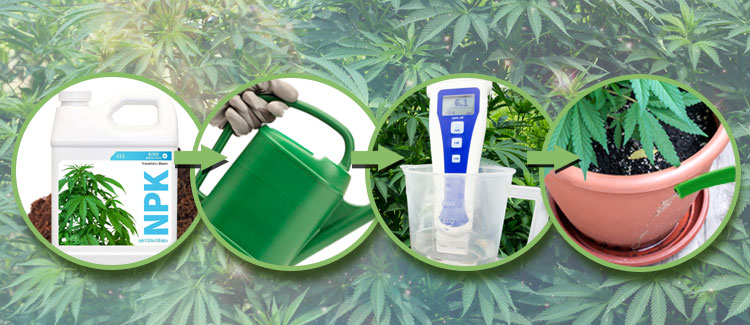
By employing a few simple techniques (and pieces of equipment), watering your weed plants can be easy and effective. Here are our top tips for beginner growers.
Water Less, But Well
Plants are used to water levels changing; they’ve evolved to not only cope, but thrive in such conditions. Therefore, letting the soil dry a bit is not just tolerable, but preferable for your plant’s roots.
Watering less often but with pH-balanced, nutrient-rich water is your best option. It is far easier to rehydrate a plant than dehydrate one.
Ensure Adequate Drainage
Excess water that cannot be held in the soil will sit in the trays beneath your pots. If you don’t have trays, invest in some to avoid a mess! Some water will be reabsorbed by the soil, so leave it for around 30 minutes. After this time, discard any water that remains in the trays.
Leaving plants sitting in excess water deprives the roots of oxygen and encourages rot and infection.
Monitor pH
An ideal pH level means your plants can optimally absorb nutrients from the soil. Too high or too low, and they will struggle to do this, leading to stunted growth or death.
Monitoring the pH of the water or nutrient solution, the soil, and the runoff will give you a comprehensive snapshot of the pH situation.
pH meters are cheap and easy to use. Testing the runoff will give you the most accurate depiction on the pH level in the soil. If it’s too high or low, correct a new solution and re-water with this. It may take several cycles until the runoff is the correct pH.
Use a Tensiometer
Tensiometers measure water tension in the soil. In doing so, they show how saturated the soil is. If they absorb water easily, then there is plenty of water; if they struggle, then the soil is drying out.
Though not essential, a tensiometer is a simple way to gauge the water content of your substrate.
How To Water Your Cannabis Plants
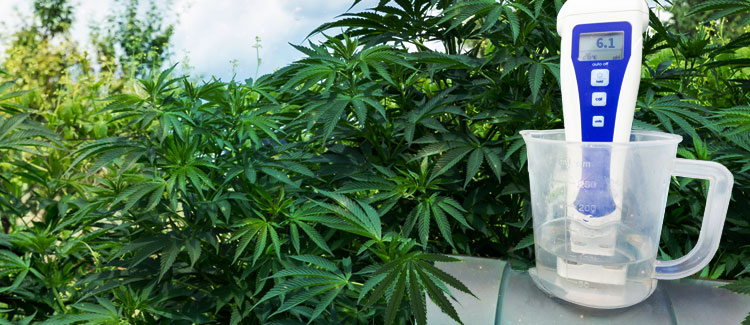
The different stages of a cannabis plant’s life cycle require different amounts of water. Recognising this will help you achieve optimal results, and happy plants. Below, we offer guidance on how to water cannabis during different stages of growth.
How To Water Cannabis Seedlings
Seedlings are fragile things, and overwatering at this stage will surely kill them. While seeds need a moist environment to open, they do not want a soaked one. Using a propagator is the simplest way to strike a balance between soil that is both sufficiently dry and humid.
During this period, seedlings can thrive in a humid environment (around 70% is perfect), but with soil that is not too wet. Using a hygrometer will help you keep the humidity where you want it to be.
What’s more, most media meant for germinating seeds will come with a suitable nutrient content already. Therefore, you should only need to add water at this stage.
Seedlings in a Hydroponic Grow
Most hydro growers germinate seeds in something like Rockwool. On the whole, the process is not too different from soil growing. The major difference lies in the fact that Rockwool is an inert medium, and therefore you will need to add some nutrients from the very beginning. Start very low though, at about 10–20% of the suggested amount.
How To Water Vegetative Cannabis Plants
Once plants enter the veg phase, they become much thirstier. In this stage, they will assume around 50% of their final mass in a relatively short amount of time, so getting watering right is conducive to optimal growth.
It’s likely that, depending on the container size, watering them between 1 and 3 times a week will suffice. Though, as stated, use this as a guide, but take the final word from the plants and the soil.
How To Water Flowering Cannabis Plants
Your plants are producing their much sought-after flowers, and it’s thirsty work! Watering will likely increase again in this stage, and the feeding regimen associated with it will change too. You’re likely to be feeding them bloom-specific nutrients and boosters at this stage, so make sure not to overwater or overfeed and cause nute burn.
Flushing
Flushing simply involves drenching the substrate in pure, pH-balanced water to wash out accumulated salts. There are two situations in which you would flush your plants.
First, if you’ve overfed them and they experience nutrient lockout or nute burn, you will need to flush the soil to begin a new feeding schedule and free up the roots to absorb nutrients again.
Second, some growers believe that depriving a plant of nutrients in the final weeks of flowering causes it to use up its reserves of nutrients, thus improving the final flavour and smoothness of the buds. Whether this is true or simply a myth is up for debate, but either way, it seems to have no negative impact on the final outcome.
How To Water Marijuana Clones
If cloning a cannabis plant, you’ll want to treat it more or less like a seedling. Put your cutting in a growing cube and place this in a propagator while it puts out new roots. 70% humidity and sparse watering are again what you’re after.
Like with seedlings, you’ll want a hygrometer to hand to ensure your clones successfully progress into the veg stage. Unlike seedlings, though, the chance of cuttings not taking root is even higher, so do your best to maintain ideal conditions.
Overwatering and Underwatering Cannabis Plants
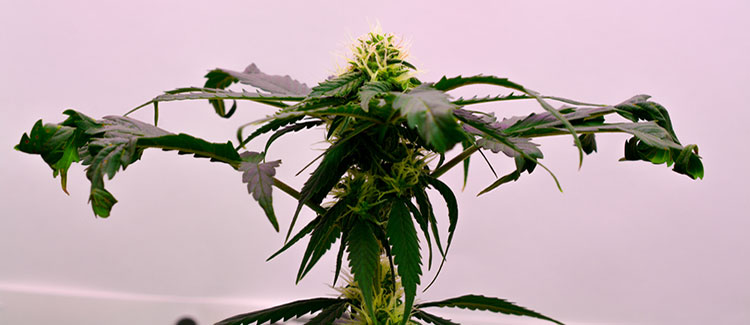
Among novice growers in particular, overwatering is one of the biggest fatal mistakes. Underwatering is less of a threat, but it can still hamper the growth of your crop if left to persist. Here’s a rundown on how to recognise and remedy underwatering and overwatering.
How To Recognise Underwatering
Signs that indicate your plants are thirsty include:
- Drooping leaves (make sure they are not saturated!)
- Lacklustre green colour
- Yellowing or browning of foliage
- Dry soil
When plants get thirsty, their once-vibrant green will begin to pale somewhat. Then, their leaves will droop, and the whole plant will begin to take on a limp, dry-looking appearance. Eventually, leaves will begin to yellow or brown, and turn crisp. All of this will likely be accompanied by dry soil.
Solution
Water your plants! Drench the entire substrate so that 10–20% runoff drains out the bottom of your containers. Your plants should perk up quite quickly.
As mentioned, overall, it’s better to water a little more infrequently, but thoroughly.
How To Recognise Overwatering
Overwatered plants can look similar to underwatered plants, but there are a few distinct signs:
- Overwatered plants retain their deep green colouration
- Appear oversaturated rather than dry
- Leaves tend to droop and discolour from the bottom upward
- The soil will be wet!
Something to bear in mind when judging your plants’ hydration level; if you water your plants and the signs of underwatering do not disappear, it’s probably not underwatered!
Solution
Depending on how far along the symptoms of overwatering are, the solution will differ. If your plants are just a little saturated and saggy, then hopefully giving the substrate time to dry out fully should be enough. Just leave them until they begin to look healthy and normal again.
If you’ve really drowned them, then you may need to repot them and cut off any rotten roots. Root rot will be evident if leaves are starting to die off. In this case, unpot your plants, remove the soil, identify and remove any rotting roots, and replant in fresh soil. Do not water for a while!
As always, prevention is the best cure, and you’d do well not to get into this situation.
Watering Cannabis When You’re Away
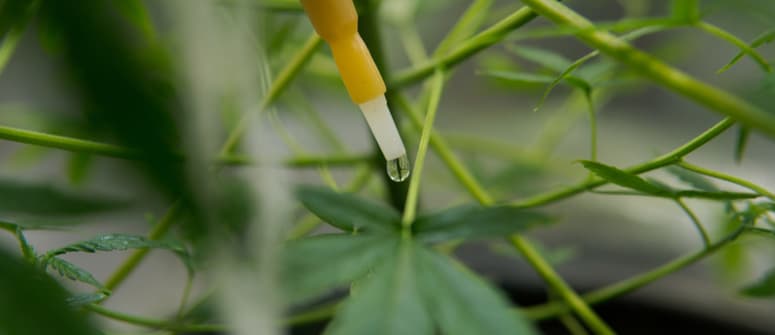
There may well come a time during your grow when you need to leave it for a time. If it’s just a few days, your best bet is to set your lights on a timer and leave it be.
If, however, you’re going to be away for a while, you’ll need to find a way to get water to your plants.
Assuming you don’t want to invest in a high-tech, automated system, there are a couple of ways to do this.
Drip Irrigation System
Drip irrigation systems are simple to set up. Using either piping with perforations or bottles with holes drilled into them, you can set it up so a constant and manageable amount of water is released. In fact, this method can be used throughout the entire grow, taking a significant amount of effort off your shoulders.
The downside to this method in your absence is that it requires a tap to be left permanently on, and if the system goes wrong, it could lead to serious flooding. This could ruin your house and alert authorities to your grow, so make sure it’s set up very securely if you’re going to leave it running for long periods.
Automatic Watering Stakes
These are easy and risk-free. Stakes placed in your soil have a wick that leads into a reservoir of water. As the roots absorb water from the stakes, osmosis pulls water from the reservoir via the wick. This is a great option if you’re only away for a little bit.
Your Weed-Loving Friends
Otherwise, you can just ask a friend! Just make sure they won’t blab, and that they understand the importance of not overfeeding or overwatering. Maybe pin this article above your water source!
Properly Watering Cannabis: Important, But Easy
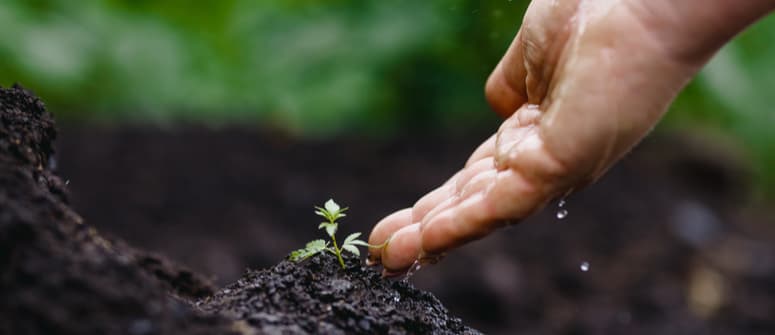
Watering cannabis is very easy, and this is almost its downfall. People assume that it’s as simple as chucking some water at a plant and watching it thrive. In reality, it takes a little more care than this—but only a little more.
Allowing a plant to dry out a little is far better for it, and far easier to deal with, than letting it saturate. Less is more!
The main takeaway from this guide is to observe your crop and the medium in which it is growing. If it looks good and the soil is damp, leave it alone! Don’t get fixated on a schedule or something you’ve heard—many factors will determine how much water your plants need, and, after all, they’re the best judges.
.jpg)
.jpg)

.jpg)
